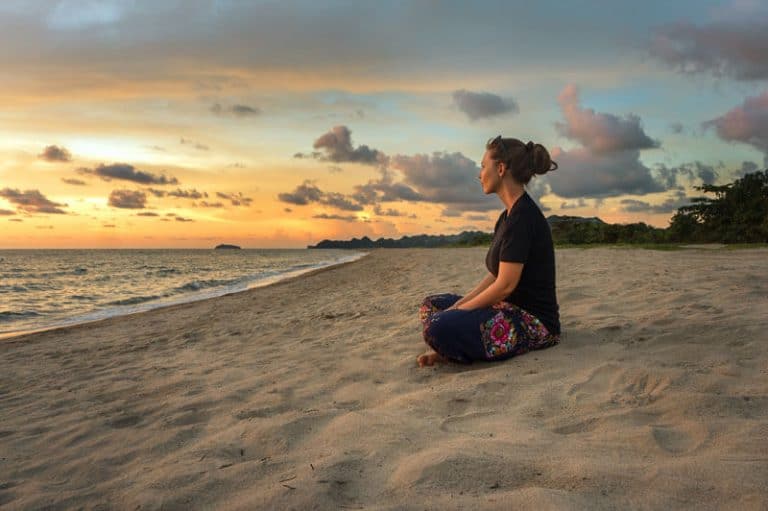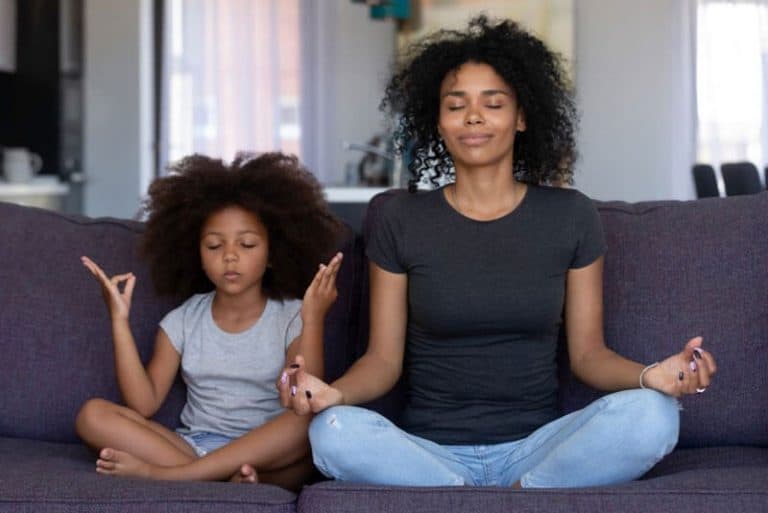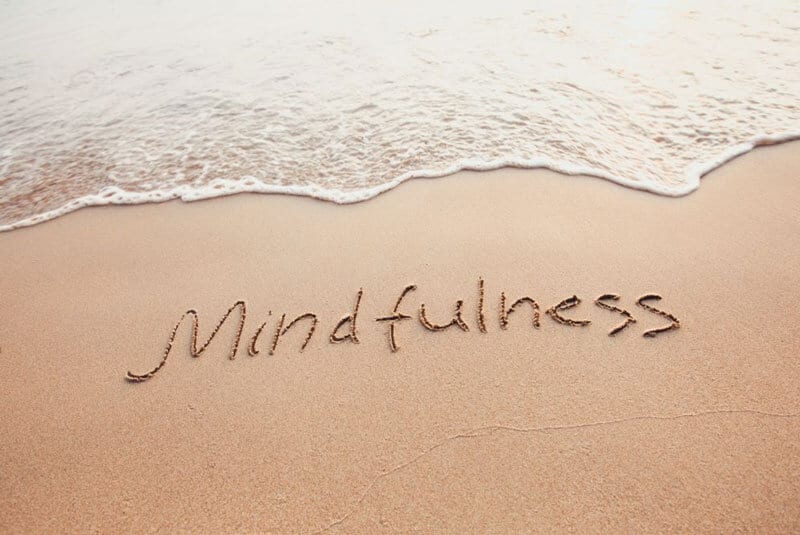In a busy world where you are doing more than one thing at once, you can lose your connection with the present. Getting the kids ready for school before you go to work, washing the dishes while on the phone and watching over the kids are, are common for busy people multi-tasking to fit everything into a day.
When was the last time you noticed the beauty of the roses in bloom and drank in their perfume or enjoyed down time with friends over a coffee? Or went outside and enjoyed the rain or stared up into the night sky to watch the stars? Can you even remember?
There may not be enough time in the day or your emotions are numb to what brings love and joy into your life in the moment. And, to top it all off, you struggle with depression or anxiety and feelings of inadequateness because every day is a struggle. Does this sound like you? Mindfulness meditation can be the answer for you.
What is mindfulness?
Mindfulness is the conscious act of focusing on the moment and accepting it for what it is without judgment. It is similar to the act of grounding yourself. Practicing mindfulness comes in many forms including meditation and using mindfulness techniques such as grounding yourself to help you cope by being kind to yourself and how you feel.
There are a multitude of scientific studies to assess how mindfulness reduces the symptoms of depression and anxiety. So, what are the benefits of using mindfulness meditation techniques for depression and anxiety? Download my free mindfulness audio program to play at anytime during the day or night to:
- help you focus
- improve your sleep
- reduce blood pressure
- help you or someone you know to fight addictions
- heighten self-awareness
- reduce memory loss as you grow older
- assist in controlling pain
- support emotional health and wellbeing
- lower stress levels
- reduce anxiety and depression.
Mindfulness benefits
Constantly dwelling on the past or worrying about the future are common when you have depression or anxiety. You can fixate on a feeling or your thoughts. And this will make you feel more depressed and heighten your anxiety. This is where practicing mindfulness can stop depression and anxiety in its tracks.
Mindfulness improves your wellbeing, and mental and physical health:
- Wellbeing. Consciously practicing mindfulness allows you to live a more joyful, satisfied life which increases your wellbeing. It helps you to look forward to and enjoy the pleasures in life, even the small ones such a watching a butterfly land on a flower or taking the time for a walk along the beach to watch the sun set or walking in your local park. Mindfulness helps you to deal better with adverse events and you will become more fully engaged with activities. When you focus on the present it is difficult to get caught up in your worries about the future or the regrets of the past, and can you form deeper connections with others.
- Mental health. Many studies show mindfulness meditation is an important part of improving mental health. It relieves depression and anxiety, eating disorders and can even help break the cycle of addiction.
- Physical health. Studies also show mindfulness is beneficial for your physical health. It can lower your blood pressure, relieve stress, helps you sleep, reduces pain and assists with heart problems among other things.
So, if you are waking up depressed and feeling anxious, practicing mindfulness is good way of dealing with this so you start the day with a positive mindset. The best thing is you can practice mindfulness at anytime, anywhere whenever you feel down or anxious.
Here we give you a guide to mindfulness to integrate into your life as a new, positive daily habit.

Tips for practicing mindfulness meditation
Practicing mindfulness allows you to breakdown your conditioned reactions to what happens to you in everyday life. The following is how to practice mindfulness so you can tune in at any time during the day or night:
- Make time. You do not need any special equipment to practice mindfulness techniques. But you do need to make time for it so set aside a little time each day. You only need 5 – 10 minutes.
- Pay attention to the present moment. It is tough to quiet your mind and that is not the aim of mindfulness. It is simpler than that. It is about paying attention to the present moment without passing judgement. While this is not as easy as it sounds, with practice it becomes easier.
- Leave judgement behind. When you start judging what you think and feel, notice and acknowledge this and then move right on by.
- Bring your mind back to the present. You will certainly get caught up in your thoughts. It is inevitable your mind will wander so do not be hard on yourself when it does. Learn to recognise when your mind wanders. Remember to bring yourself back to the present moment.
While it is said mindfulness is simple, and it is, that does not mean it is easy. It takes practicing it on a regular basis for its benefits to accrue. Don’t forget to download my free mindfulness audio program. It will help you.

Mindfulness meditation instructions
Practising mindfulness techniques starts with your breathing. The unwanted thoughts of anxiety and depression can cause shallow, fast or laboured breathing that comes from the chest. Mindful breathing slows your breathing down and comes from deep within your belly. It returns you heart rate to a steady pace, and reduces your feelings of depression and anxiety, and clears your mind. Mindfulness helps ground you in the present moment.
Simple meditation to get you started
Before you start, download my free mindfulness audio program to help to remove your focus from your thoughts. Find a comfortable place to sit where you will not be disturbed as you meditate.
Now, are you ready to begin?
Here are some simple mindful meditation instructions:
- Get comfortable. Find a place where you are comfortable, inside or outside. Sit in a chair or on the ground cross-legged in a comfortable position. If sitting in a chair, let your feet rest on the ground. Sit with your upper body straight but relaxed without being stiff. Make sure your arms are parallel with your body with your hands resting naturally on your legs.
- Relax your gaze. Relax your gaze by dropping your chin and do not focus on what you see. You do not need to close your eyes, but you can if you like. The key is not to focus on anything.
- Focus on your breathing. Take notice of how it feels as you breathe in through your nose and out through your mouth. Here is how:
- For a count of four seconds inhale through your nose slowly.
- Pause and hold your breath for a count of one.
- Exhale slowly for a count of four seconds without rushing. Take notice of how it feels to breathe.
- Continue breathing this way until you notice a change in how you feel both mentally and physically.
- Notice when your mind wanders. It is inevitable your mind will wander as you focus on your breathing. Do not worry about it. Let those thoughts go and bring your focus back to your breathing. Avoid letting those thoughts take over. You may have to refocus on your breathing over and over.
- Do not stress when your mind wanders. Do not stress when your mind wanders. It is completely natural. Instead, observe your thoughts without reacting to them and then let them go.
- Refocus on your surroundings. When you are ready, start refocusing on your surroundings. And, if you have closed your eyes, open them and take notice of what you can hear around you. Take notice of how your body feels, as well as your thoughts and emotions.
Now you are ready to continue with what you need to achieve for the rest of the day.

Tips to ground yourself
There may be times when you cannot practice mindfulness meditation when anxiety or depression hits you. But you can still practice deep breathing wherever you are and as you do, try the following to ground yourself:
- Take notice of your immediate surroundings.
- Consciously name five things you can see—tree, computer, table, coffee cup and people.
- Name four things within touching distance—chair, desk, pillow and your hair.
- Name three things you can hear in your environment—people talking, a dog barking and a plane flying overhead.
- Say the name of two things you can smell—fresh coffee and the perfume of the flowers nearby.
- Name something you can taste—the coffee or tea you are drinking.
By the time you finish doing this, your feelings of anxiety or depression will fade into the background because you have grounded yourself in the present.

Get help
When you are not coping with depression or anxiety, contact us to find out how we can help you get your life back on track. But, if you are in crisis, call us immediately. We can help lift your depression, anxiety and stress quickly to help you deal with things better. We can work with you in our Spas, over the phone or via Skype. Book in today for my Emotional Empowerment Program. I have an introductory offer for just $79 so you can start taking back control of your life. We can help you replace depression and anxiety with a renewed energy and love of life. Invest in yourself today.
Let me help stop the effects of mental health issues
My Emotional Empowerment Program has helped thousands of people like you control their mental health issues so they live happier lives. With my help you can learn to stop these crippling symptoms taking over your life without the use of prescribed medications. I can help you replace depression and anxiety with happiness, peace and contentment in weeks not years. Have a listen to what Lydia has to say about my program after only a few sessions.

